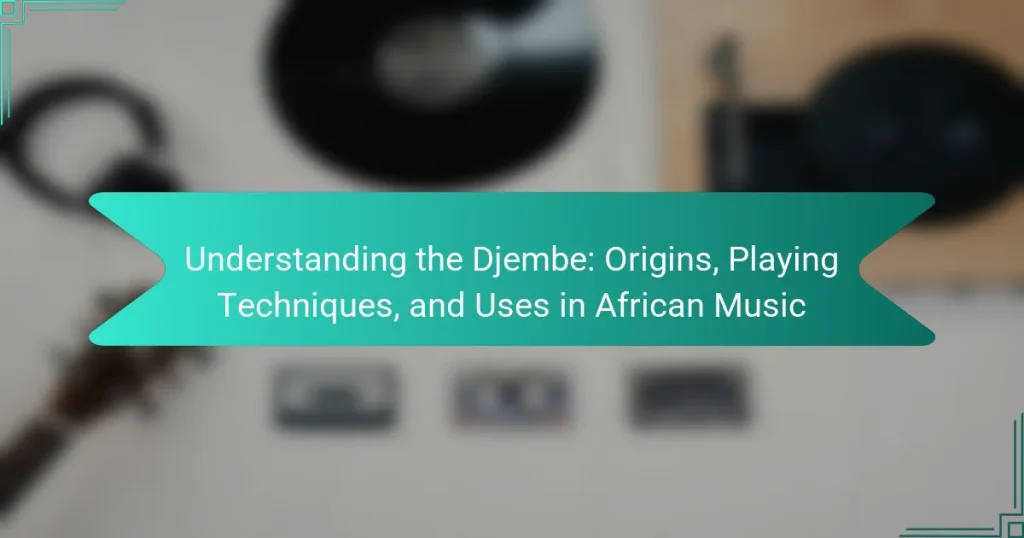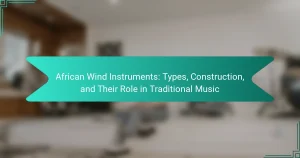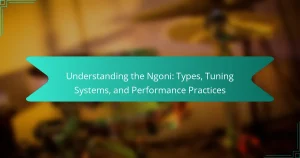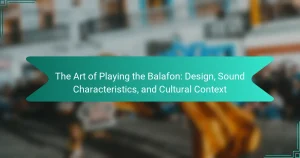The Djembe is a traditional African drum carved from a single piece of wood, featuring a drumhead made from animal skin, primarily used by the Mandinka people of West Africa. This instrument produces a variety of sounds through techniques such as bass, tone, and slap strokes, allowing for expressive playing in multiple musical genres. Historically significant in ceremonies and celebrations, the Djembe also serves as a communication tool, enhancing storytelling and community bonding. Its versatility and rich sound make it a staple in both traditional and contemporary music contexts. The article explores the Djembe’s origins, playing techniques, and its role in African music, highlighting its cultural importance and adaptability.
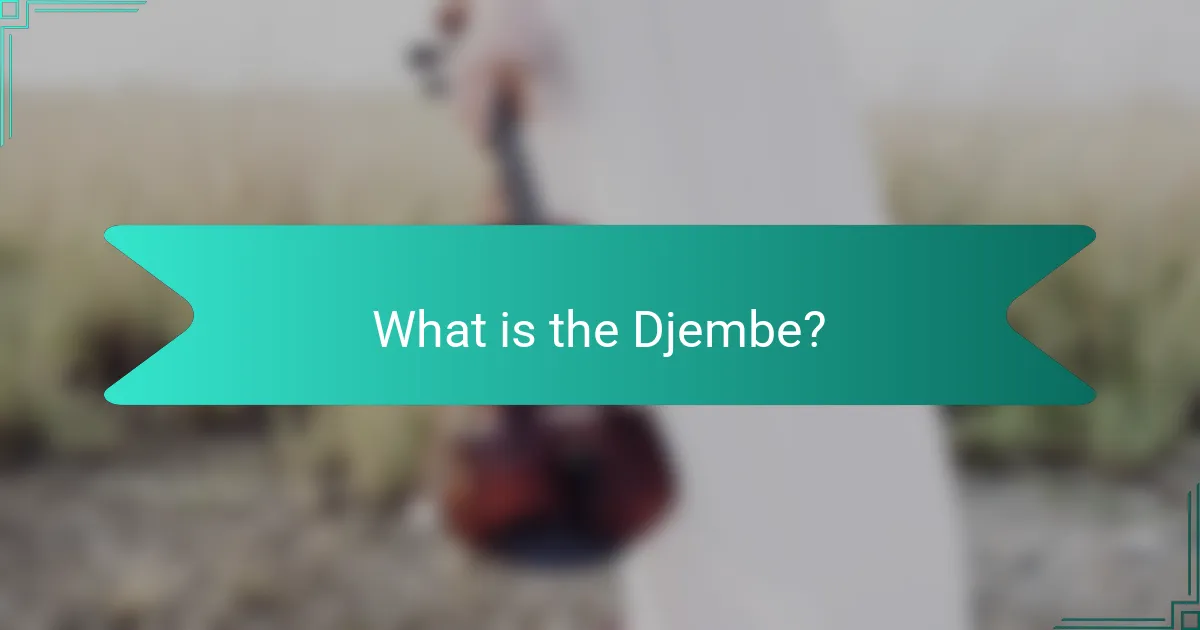
What is the Djembe?
The Djembe is a traditional African drum. It is carved from a single piece of wood and has a drumhead made from animal skin. The Djembe originates from West Africa, particularly among the Mandinka people. It is played with bare hands, producing a wide range of sounds. The drum is known for its deep bass tones and sharp slaps. Historically, it was used in ceremonies and celebrations. Today, the Djembe is popular worldwide in various musical genres. Its versatility makes it a staple in both traditional and contemporary music.
How did the Djembe originate?
The Djembe originated in West Africa, specifically among the Mandinka people. It is believed to have been created in the 12th century. The drum was traditionally made from a single piece of wood and animal skin. Djembe means “everyone gather together” in the Mandinka language. This reflects its role in community gatherings and celebrations. The Djembe was used in various ceremonies, including weddings and harvests. It serves as a communication tool and a means of storytelling. Its construction and playing techniques have been passed down through generations.
What historical contexts influenced the creation of the Djembe?
The Djembe originated in West Africa, influenced by various historical contexts. It emerged during the Mali Empire, which thrived from the 13th to 16th centuries. The drum served as a communication tool among tribes, conveying messages over long distances. It was also integral to ceremonies, celebrations, and rituals, reflecting cultural traditions. The craftsmanship involved in making the Djembe was passed down through generations, showcasing the importance of oral history. Additionally, the transatlantic slave trade impacted its spread, as enslaved Africans brought the Djembe to the Americas. This historical journey contributed to the evolution of musical styles globally.
Which cultures contributed to the development of the Djembe?
The Djembe drum was primarily developed by the Mandinka people of West Africa. This culture is known for its rich musical traditions and communal gatherings. The Djembe is also influenced by the cultures of the Malinke and Bambara peoples. These groups contributed to the techniques and rhythms associated with Djembe playing. Additionally, the influence of the Dogon culture can be seen in the ceremonial uses of the Djembe. The drum’s design and construction are rooted in the craftsmanship of various West African tribes. Each culture added unique attributes, enhancing the Djembe’s significance in African music.
What are the key characteristics of the Djembe?
The Djembe is a goblet-shaped drum originating from West Africa. It is traditionally carved from a single piece of wood. The drumhead is made from animal skin, typically goat, which contributes to its unique sound. Djembe drums are known for their versatility in producing a wide range of tones. They can produce bass, tone, and slap sounds. The drum is played with bare hands, allowing for intricate rhythms. Djembe is often used in communal gatherings, celebrations, and ceremonies. Its cultural significance is rooted in African traditions and storytelling.
What materials are commonly used in Djembe construction?
Djembe construction commonly uses wood, animal skin, and rope. The shell is typically made from hardwoods like mahogany or iroko. These woods provide durability and resonance. The drumhead is usually crafted from goat or cow skin. This material is chosen for its ability to produce a range of tones. Rope is used to secure the drumhead to the shell. This ensures proper tension and sound quality. The combination of these materials contributes to the unique sound of the djembe.
How does the shape of the Djembe affect its sound?
The shape of the Djembe significantly affects its sound. The Djembe has a goblet shape, which enhances its ability to produce a wide range of tones. The narrow top allows for higher pitches, while the wider base creates deeper sounds. This design enables the drum to produce distinct slap, tone, and bass sounds. The thickness of the drum shell also influences resonance. Thinner shells produce brighter sounds, while thicker shells yield warmer tones. Additionally, the materials used in construction interact with the shape to further define the sound quality. Historical use of the Djembe in various African cultures showcases its versatile sound capabilities.
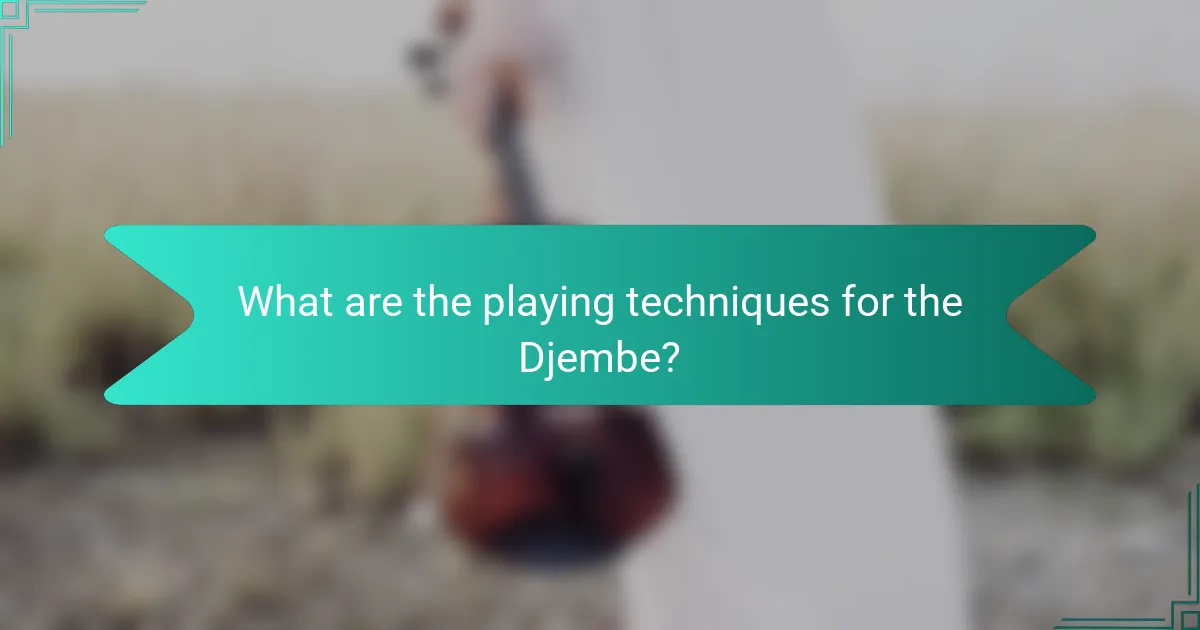
What are the playing techniques for the Djembe?
The playing techniques for the Djembe include several fundamental strokes. The primary strokes are bass, tone, and slap. The bass stroke is produced by striking the center of the drum with a flat hand. This creates a deep, resonant sound. The tone stroke is made by hitting the edge of the drum with the fingers, producing a higher pitch. The slap stroke involves striking the drum’s edge with a cupped hand, resulting in a sharp, crisp sound.
Additionally, drummers use variations like the open tone and closed tone. The open tone allows for a fuller resonance, while the closed tone dampens the sound. Techniques also include finger rolls and drum fills to enhance rhythm complexity. Mastery of these techniques allows for expressive playing in various musical contexts.
How do you properly hold a Djembe?
To properly hold a Djembe, position the drum between your legs. Your legs should form a V-shape to stabilize the drum. Keep the drum tilted slightly away from you. This angle allows for better sound projection. Use your dominant hand to strike the drumhead. The fingers should be relaxed but firm. The other hand should rest lightly on the rim for support. This technique helps maintain control while playing. Proper grip and positioning enhance sound quality and playing comfort.
What hand positions are recommended for playing the Djembe?
The recommended hand positions for playing the Djembe include the open palm, the flat hand, and the finger tip. The open palm technique produces a deep bass sound. The flat hand creates a resonant tone. The finger tip position allows for sharp, high-pitched notes. Each position is crucial for achieving different sounds and rhythms. Mastery of these hand positions enhances playing technique. Proper hand positioning contributes to the overall quality of sound produced. These techniques are widely taught in Djembe classes and workshops.
What is the importance of posture while playing?
Posture is crucial while playing the djembe. Proper posture enhances control and technique during performance. It allows for optimal hand movement and reduces the risk of injury. Good posture promotes better sound production. It also aids in breath control, which is essential for rhythm. Studies have shown that musicians with correct posture perform better. For example, musicians who maintain an upright position can play for longer durations without fatigue. This is vital for sustaining energy during performances. Overall, correct posture significantly impacts performance quality and musician health.
What basic rhythms can be played on the Djembe?
Basic rhythms that can be played on the Djembe include the “Bass,” “Tone,” and “Slap.” The Bass rhythm is produced by striking the center of the drum with a flat hand. The Tone rhythm is created by striking the edge of the drum with the fingers. The Slap rhythm involves a quick, sharp strike at the drum’s edge, producing a higher-pitched sound. These foundational rhythms form the basis of many traditional African music patterns. Mastery of these basic rhythms is essential for effective Djembe playing.
How do traditional African rhythms differ from contemporary rhythms?
Traditional African rhythms emphasize polyrhythms and communal participation, while contemporary rhythms often focus on individual expression and simplified structures. Traditional rhythms are deeply rooted in cultural practices and ceremonies. They utilize complex layering of multiple rhythms played simultaneously. Instruments like the djembe are central to these traditional forms. Contemporary rhythms, influenced by global music trends, often prioritize accessibility and mainstream appeal. They may incorporate electronic sounds and simplified time signatures. The evolution of music genres, such as Afrobeat, shows a blend of traditional and contemporary elements. This blending illustrates the dynamic nature of rhythm in African music today.
What are some common patterns used by Djembe players?
Common patterns used by Djembe players include the basic stroke patterns known as bass, tone, and slap. The bass stroke produces a deep sound and is created by striking the center of the drum with the palm. The tone stroke is a higher-pitched sound made by striking the edge of the drum with the fingers. The slap stroke is a sharp, cutting sound created by striking the edge with a quick wrist motion.
These patterns can be combined to create complex rhythms. For example, the “Kuku” rhythm incorporates these three strokes in a specific sequence. Another common pattern is the “Djembe solo,” which showcases improvisation and skill.
These patterns are foundational in traditional West African music. They allow Djembe players to participate in ensemble playing, enhancing the overall musical experience.
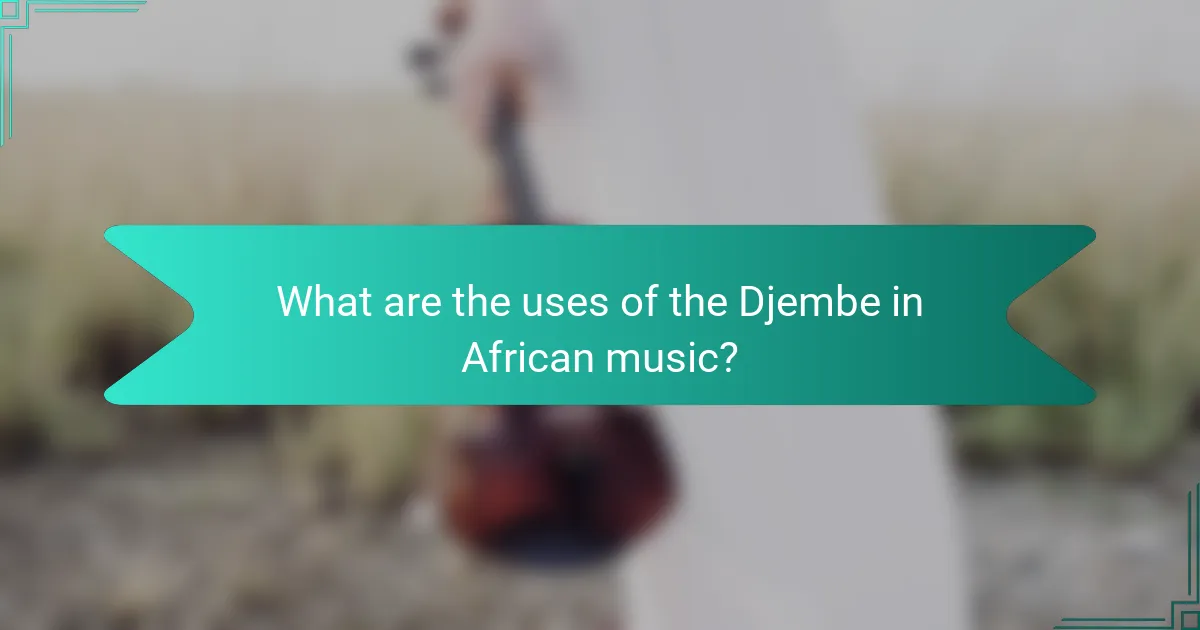
What are the uses of the Djembe in African music?
The Djembe is used in African music for various purposes, including ceremonial functions, social gatherings, and storytelling. It serves as a communication tool, conveying messages through rhythm. The Djembe is central to traditional rituals, such as weddings and funerals, providing a rhythmic backdrop. In social settings, it enhances community bonding during celebrations. The drum also accompanies dancers, enriching performances with its vibrant sounds. Historically, the Djembe has been integral to oral traditions, aiding in the transmission of history and culture. Its versatility allows for different playing techniques, producing a range of sounds suitable for various musical styles.
How is the Djembe integrated into traditional African ceremonies?
The Djembe is integral to traditional African ceremonies. It serves as a primary instrument for communication and expression during rituals. The drum accompanies dances, prayers, and celebrations, enhancing the spiritual atmosphere. Specific rhythms are associated with various ceremonies, such as weddings and funerals. In many cultures, the Djembe is played to invoke ancestral spirits or mark significant life events. The presence of the Djembe fosters community bonding through collective participation in music and dance. Its role in ceremonies underscores its cultural significance and connection to African heritage.
What roles does the Djembe play in cultural celebrations?
The Djembe serves as a central instrument in cultural celebrations. It facilitates community bonding through shared music and dance. The rhythms played on the Djembe often accompany traditional ceremonies, including weddings and harvest festivals. These rhythms convey emotions and stories, enhancing the celebratory atmosphere. The Djembe also acts as a means of communication, signaling important moments during events. Its use in celebrations reflects cultural identity and heritage. Historical records indicate that the Djembe has been integral to West African traditions for centuries. The instrument fosters unity and joy, making it essential in various cultural festivities.
How does the Djembe contribute to storytelling in music?
The Djembe contributes to storytelling in music by providing a rhythmic foundation that enhances narrative expression. Its unique tonal qualities allow for a range of emotions to be conveyed. The drum’s sounds can mimic voices, creating a dialogue within the music. Traditionally, Djembe players use specific rhythms to represent various stories or events. Each rhythm has cultural significance and can evoke specific memories or feelings. For instance, certain patterns are associated with celebrations, while others may represent sorrow or reflection. This connection between rhythm and story is a vital aspect of African oral traditions. The Djembe thus serves as both a musical instrument and a storytelling medium, bridging generations through shared narratives.
What contemporary applications does the Djembe have?
The Djembe is used in various contemporary applications, including music therapy, cultural education, and performance art. In music therapy, it aids in emotional expression and social interaction. Educational programs utilize the Djembe to teach rhythm and teamwork in schools. Additionally, it is featured in live performances and festivals, showcasing its cultural significance. The Djembe also serves as a tool for community building through drumming circles. These applications highlight its versatility beyond traditional uses.
How is the Djembe used in modern fusion music?
The Djembe is used in modern fusion music as a versatile percussion instrument that adds rhythmic complexity. Its unique tonal qualities enhance genres like jazz, rock, and world music. Artists incorporate the Djembe to create a blend of traditional African rhythms with contemporary sounds. This fusion allows for innovative musical expressions. Notable musicians have popularized its use in various collaborations. The Djembe’s adaptability makes it a favorite in live performances and recordings. The instrument’s presence in fusion music highlights its cultural significance and global appeal.
What impact does the Djembe have in global music scenes?
The Djembe significantly influences global music scenes by introducing African rhythms to diverse cultures. It serves as a key instrument in various musical genres, including world music, jazz, and pop. The Djembe’s unique sound and playing techniques have inspired musicians worldwide. It promotes cross-cultural collaboration through drumming workshops and festivals. The instrument’s popularity has led to its incorporation in educational programs and community events. This fosters a deeper appreciation for African music traditions. Studies indicate that exposure to Djembe music enhances creativity and social cohesion among participants. Thus, the Djembe plays a vital role in shaping contemporary music landscapes globally.
What tips can improve your Djembe playing experience?
To improve your Djembe playing experience, focus on proper hand positioning. Correct hand placement enhances sound quality and reduces strain. Maintain relaxed shoulders and a comfortable posture while playing. This helps prevent fatigue during longer sessions. Practice regularly to develop muscle memory and improve rhythm. Consistent practice leads to better coordination and timing. Experiment with different striking techniques to diversify your sound. Each technique produces unique tones and textures. Listening to experienced players can also provide valuable insights. Observing their techniques can inspire your own playing style. Engaging with a community of Djembe players fosters learning and motivation. Sharing experiences enhances your understanding and enjoyment of the instrument.
The Djembe is a traditional African drum originating from West Africa, particularly associated with the Mandinka people. This article explores the Djembe’s historical context, construction materials, and key characteristics, including its unique goblet shape and versatile sound production. It also details playing techniques, fundamental rhythms, and the drum’s significance in traditional ceremonies and contemporary music. Additionally, the article highlights the Djembe’s role in storytelling, cultural celebrations, and its impact on global music scenes, providing insights into its applications in music therapy and fusion genres.
